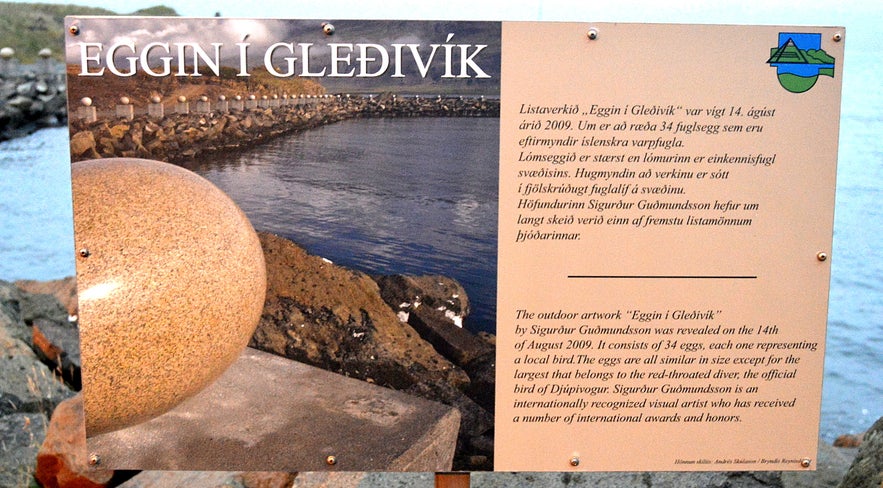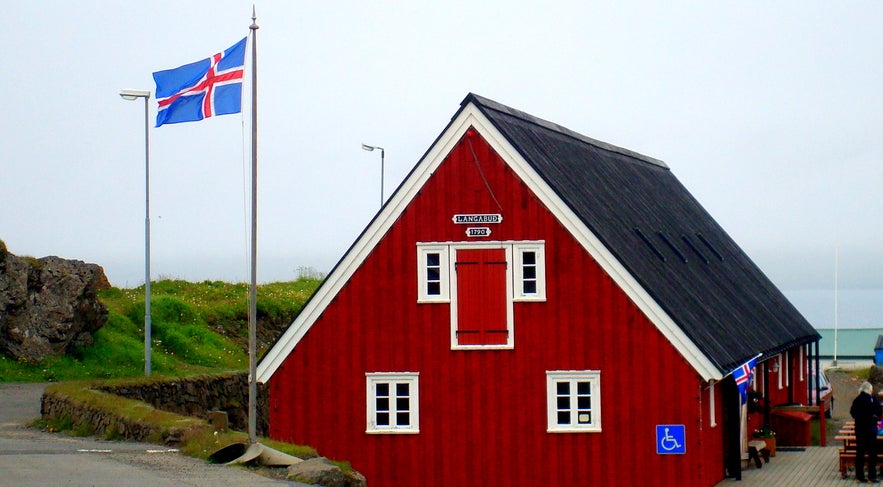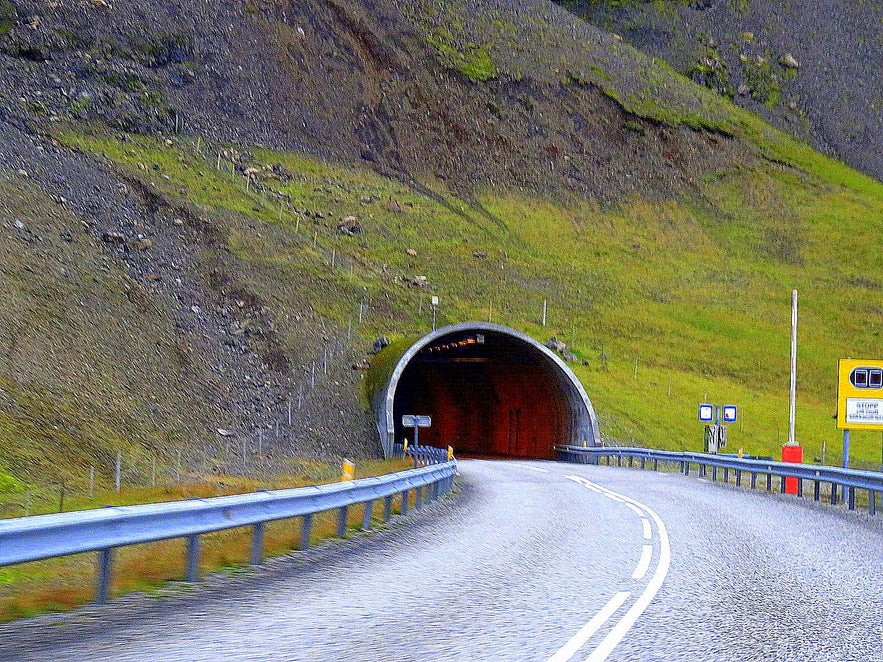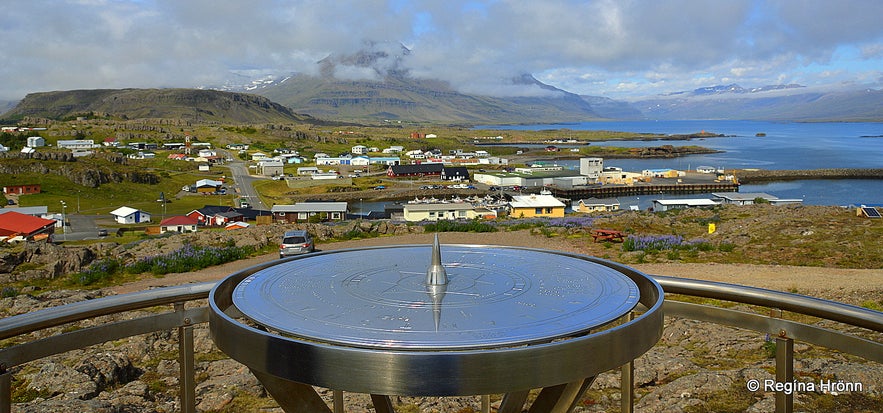
Djúpivogur Village in East-Iceland and the Eggs at Gleðivík Bay
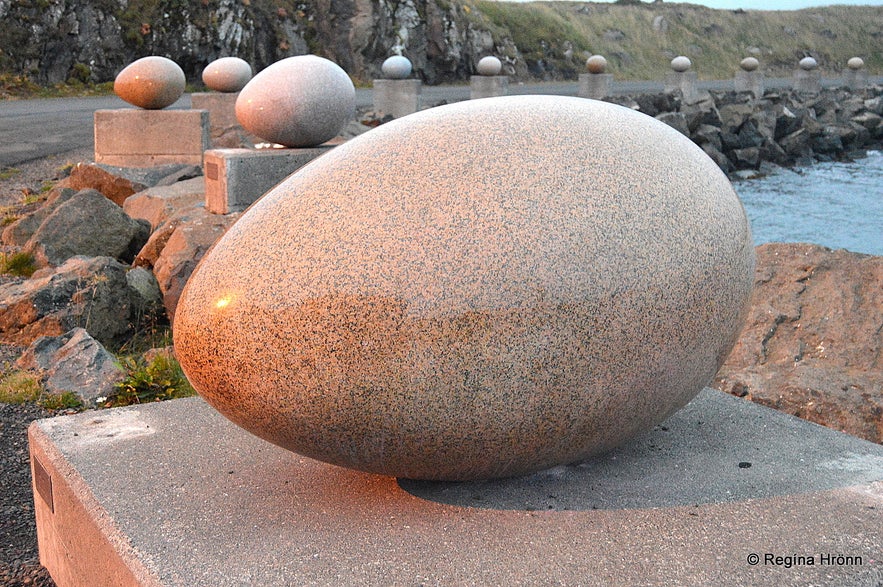
By the harbour in the lovely little village of Djúpivogur in East-Iceland, you will find a bay called Gleðivík or Merry bay. In that bay, a hidden treasure is to be found - a distinctive outdoor artwork hidden away from sight.
This is an artwork by the popular Icelandic visual artist, Sigurður Guðmundsson, called Eggin í Gleðivík - the Eggs at Merry bay. The noted artist Sigurður Guðmundsson has received several international awards for his visual artwork.
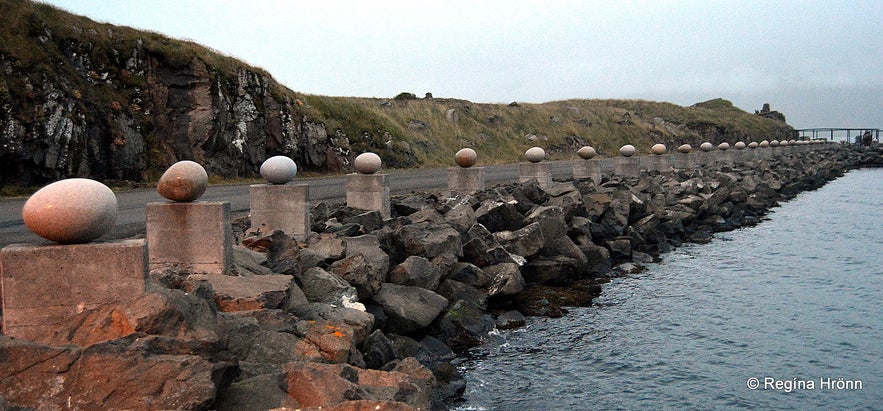
Eggin in Gleðivík - the Eggs at Merry bay
The outside artwork consists of 34 huge granite eggs which represent the eggs of each of the nesting birds in this area, many of which are migrating birds, flying over to Iceland from far away to lay their eggs in Iceland.
The Eggs at Merry bay are made of Chinese granite and imported from China, where the artist Sigurður lives part of the year with his wife. They also own a home in Djúpivogur village called Himnaríki or Heaven.
The granite eggs are all of the same or similar size apart from one, which is much bigger than the others. This distinctive artwork was revealed on the 14th of August 2009 and on the official website of Djúpivogur village you can see photos from the revealing of the eggs.
The information sign by Eggin in Gleðivík - the Eggs at Merry bay
The molten plinths in Merry bay are remnants from the landing of fish by the port. Here fish was landed and transported by a conduit on the plinths into the rendering of the fish-factory Bræðslan. The old fish factory now hosts an exhibition of contemporary art in the summertime. Times have changed here in the little fishing village of Djúpivogur.
The District Manager of Djúpivogur had been pondering on what could be done with these old plinths, so he consulted the visual artist Sigurður Guðmundsson. Sigurður immediately came up with the idea of the granite eggs and put his idea into action. He said by the inauguration of his artwork that he had never created such a big artwork in such a short time, but the artwork itself is 200 meters long!

A photo of my last visit to Djúpivogur, again dusk setting in, but brighter than during my first visit
Each one of the 34 eggs is an exact replica of the egg of the bird in question.
The eggs are all different in shape, nuance, and colour. Most of the bird species represented by the eggs are migratory and the best bird-watching time in Iceland is from June to August.
It is such beautiful artwork, eggs represent growth, new beginnings, and the future, and it is amazing how many emotions the Eggs of Merry bay can stir up :)
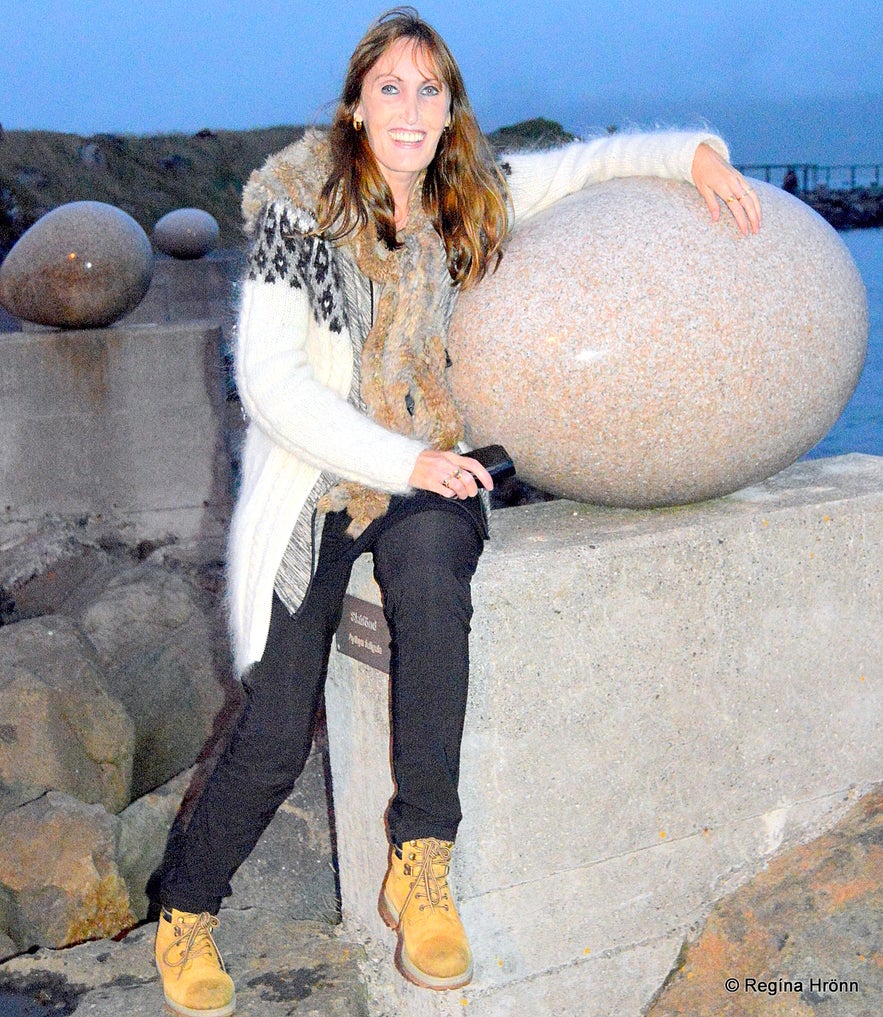
Eggin in Gleðivík - the Eggs at Merry bay - here you can see how big they are
The Eggs of Merry bay have become the main attraction of Djúpivogur and I am sure that one day they will become the symbol of the village. Small castings of the eggs in a gift box can be bought in Djúpivogur village. I think they would make a lovely gift for bird watchers.
My photos were shot in the twilight on a September night, but I upped the light a bit so the eggs can be seen in the photos.
I add two photos of myself by the eggs so that you can see how big they really are. The biggest one is much bigger than the other ones and represents the egg of the official Djúpivogur bird, lómur, the red-throated diver.
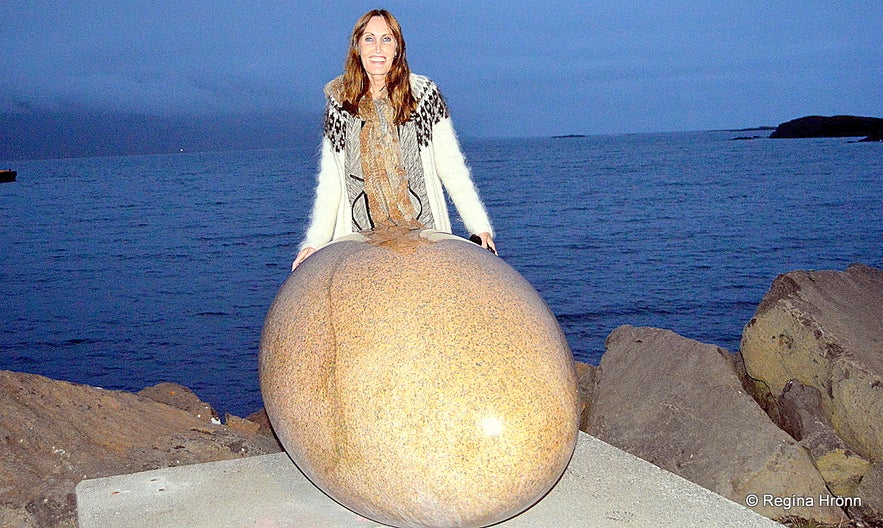
By Eggin in Gleðivík - the Eggs at Merry bay
You will find a sign leading to Gleðivík - Merry bay, which is just outside the village, or some 900 meters from the village centre.
There is more to see in Djúpivogur though, but I just wanted to point the eggs out to you as they are hidden away when you enter the village. I would not want you to visit Djúpivogur without seeing these huge eggs of Merry bay.
The latest I heard about the eggs is that there are plans about moving them as a fatal accident took place in Gleðivík bay.
Langabúð in Djúpivogur
The inhabitants of Djúpivogur are only 454 and fishing, fish processing and tourism are the main industries in this little village. The Cultural Centre of Djúpivogur, located in the beautiful red-painted timber house called Langabúð, hosts a section devoted to the noted sculptor and woodcarver Ríkarður Jónsson (1888-1971).
Langabúð is the oldest house in Djúpivogur, built in 1790 - it is fitting that Ríkarður's memory and work are honoured in the house in which he was born.
Langabúð was built on the ruins of other even older buildings from 1589, but back then German merchants started trading with Djúpivogur. The Danish Trading Monopoly then took over the trading in 1602-1786!
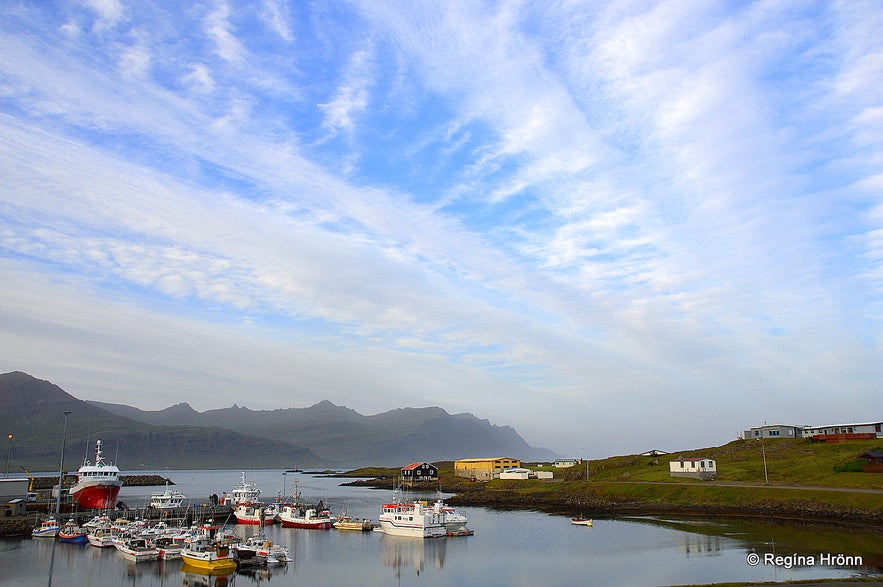
Djúpivogur harbour
The pyramid-shaped Mt. Búlandstindur (1,069 m) is the landmark of Djúpivogur - we believe that some special powers are at work in this mountain.
Due to the Austfjarðaþoka or the Fog of the Eastfjord I have not always been able to get a decent photo of Mt. Búlandstindur. The Fog of the Eastfjords is a well-known phenomenon here in Iceland.
Finally, in 2020 I was able to get a decent photo of Mt. Búlandstindur while visiting the distinctive Blábjörg - the Blue cliffs in Berufjörður fjord.
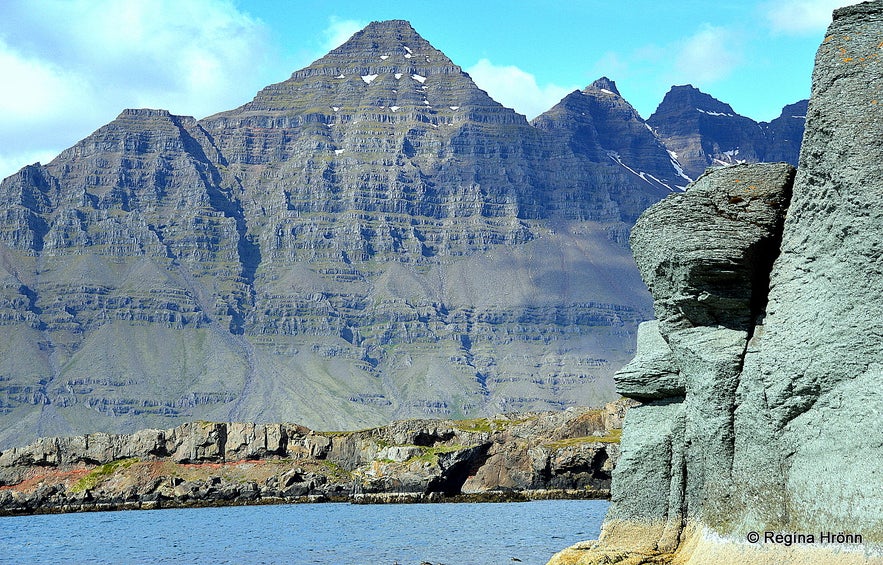
Mt. Búlandstindur and Blábjörg cliffs in Berufjörður fjord
In the summertime, there are daily boat tours to Papey island - the Friar's island, which is named after the Irish monks, who were here in Iceland along with other Irish people (or that is what we think) when the Vikings arrived around year 874.
When the Vikings settled Iceland the monks seem to have left. We don't know the whole story though, but there are some speculations about Irish people having settled in Iceland before the Vikings arrived.
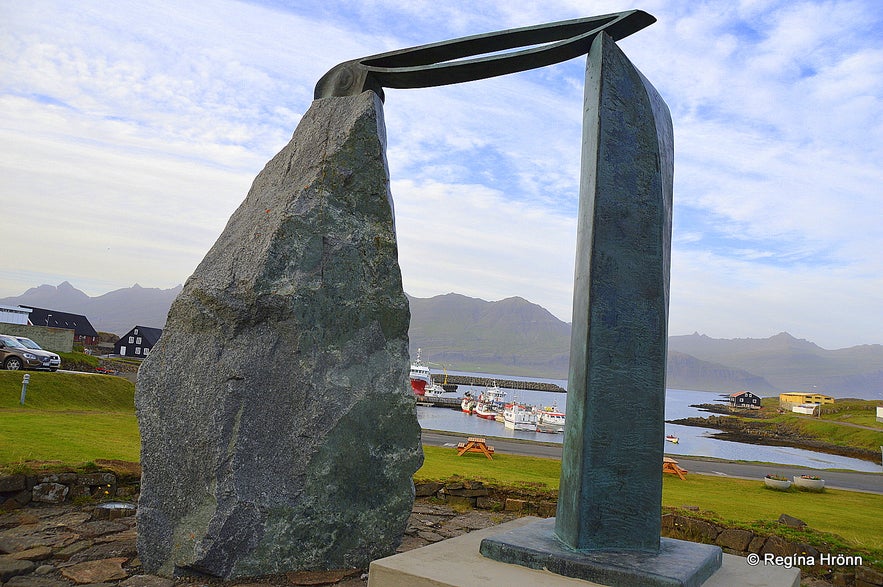
Artwork in Djúpivogur
Back in 1989, I went to Djúpivogur to catch a ride on a freight ship carrying salt cod (bacalao) from Djúpivogur to Portugal.
I was young and wanted to save some money so instead of flying to Portugal, my girlfriend and I decided on catching a ride on this freight ship, even though it meant that we would be sailing for 5 days before reaching Portugal ;)
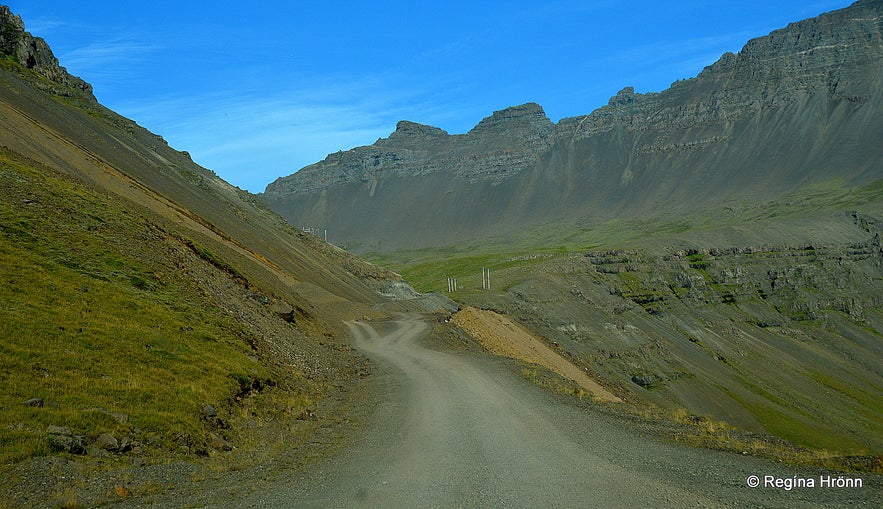 Almannaskarð pass - the old road
Almannaskarð pass - the old road
Back then there was no tunnel through the steep Almannaskarð pass from Höfn so we had to drive up the steep mountain.
My girlfriend and I had booked a night at Hotel Höfn and had just gone to sleep when we were awakened by the captain of the freight ship telling us that they were leaving earlier - in the middle of the night to be exact and that he had already sent one of his crew-members to pick us up!
That guy drove up the steep mountain of Almannaskarð pass at a speed of 100 km/hour - scaring the living daylights out of us!
The Almannaskarðsgöng tunnel
I am very grateful for the 1.3 km long Almannaskarðsgöng tunnel on ring-road 1, which was opened in 2005 leading from just east of the town of Höfn and up to the Eastfjords of Iceland!
The view-dial in Djúpivogur by Bóndavarða
Here clouds are blocking the view of Mt. Búlandstindur
Where ever I travel in Iceland I always look for a view-dial, as the making of these view-dials runs in the family, as it were. The chromium-plated view-dial in Djúpivogur was erected in 1997.
It has got a time of three hours (eyktir) and shows the outlines and the names of the surrounding mountains.
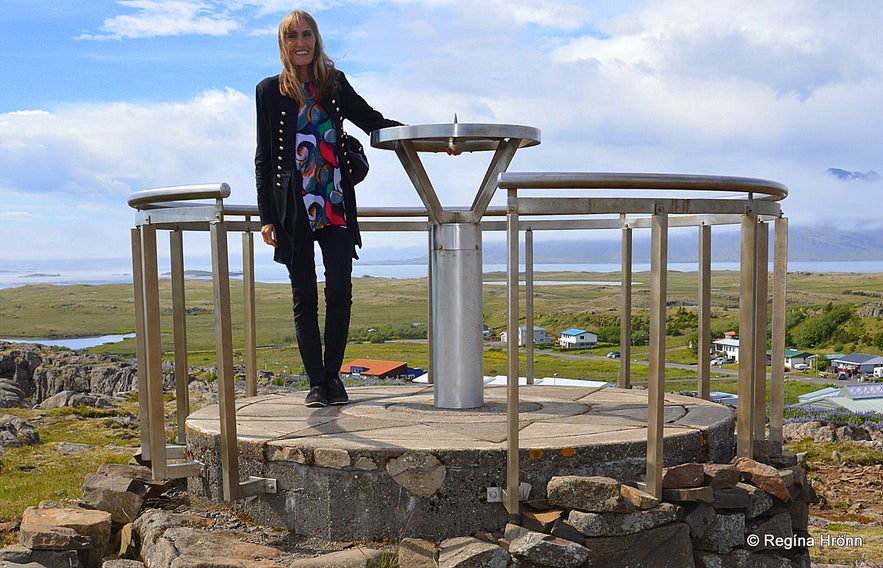
By the view-dial by Bóndavarða
This view-dial was designed by my father-in-law, Jakob Hálfdanarson, and his assistants were Jón Víðis Jakobsson (my husband) and Þórný Björk Jakobsdóttir (my sister-in-law).
The design of the view-dial is so pretty, it is placed on a grid on top of a steel pillar and surrounded by steel railing. The molten base is in the image of a star.
The view-dial in Djúpivogur is located by Bóndavarða from where there is a great view.

The view-dial by Bóndavarða
To reach Djúpivogur in East Iceland you can rent a car in Reykjavík and drive for some 554 km from Reykjavík on ring-road 1 or 104 km if you come from the town of Höfn in the south-east.
A sign leads you to Gleðivík from Djúpivogur's centre. The egg sculptures are just outside the village, about 900 m away.
I have written several other travel-blogs about East Iceland if you want to know more about this beautiful part of Iceland:
East Iceland is dotted with beautiful little villages and hidden secrets
The Eastfjords of Iceland - the beautiful Fjords in Fjarðabyggð
Have a lovely time in East Iceland :)
其他有意思的博客
冰岛最浪漫的角落
对于很多人,遥远的冰岛有着世界尽头的神秘,有着区别于巴黎、马尔代夫、自成一体的浪漫。没有埃菲尔铁塔和蒂凡尼,没有热带沙滩,而是在冰川、火山、苔藓地的背景下蜜月旅拍、婚拍,甚至举办一场冰岛婚礼。来冰岛旅行,多是要跨千山万水、飞跃大洋大陆,很有一点“万水千山陪你走过”的史诗感。难怪很多人说,光是冰岛二字,就足够浪漫了。 冰岛虽然不大,但是地貌极其丰富,不同的自然景观自然有不同的气质。这一篇,就挑阅读更多从极光观测到摄影-到底该不该来冰岛看极光
很多朋友都想来冰岛看极光,但是冰岛到底适不适合看极光呢?几月、什么季节能看到极光?是不是一定要参加北极光旅行团?如何能拍摄出美丽的极光照片呢?在冰岛住了好几年了,从刚开始逢极光必出门,到如今家里阳台就能看极光,我对在冰岛看极光的了解和经验,也算得上大半个专家了,且听我娓娓道来吧。 到底该不该来冰岛看极光呢?最坦诚的答案是,不要只为了看极光而看极光。 极光原理 太阳活动→太阅读更多
迷失冰岛的米湖游览推荐|不只有温泉的地热宝藏区
我在冬夏秋均到访过米湖,看过米湖的不同面。一直以来,米湖到底值不值得去是很多游客争论的问题。有些人觉得这里是来冰岛旅行的必去目的地,有些人则说米湖“太丑了”,连照片都不想多拍几张。那米湖到底值不值得来呢?到底怎么玩呢? 米湖的风景 北部的米湖,因地理位置相距首都雷克雅未克略远,很多来冰岛的短途游客选择放弃,其实米湖应该是和黄金圈、南岸沿线至冰湖齐名的冰岛景色,这里冷热相融,可谓最冰岛,尤其阅读更多

将冰岛最大的旅行平台下载到您的手机中,一站式管理您的整个行程
使用手机摄像头扫描此二维码,然后点击显示的链接,将冰岛最大的旅行平台添加到您的手机中。输入您的电话号码或电子邮件地址,以接收包含下载链接的短信或电子邮件。

